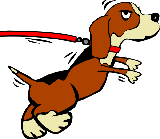Dog SuppliesCrates And Toys For Dogs |
|
|
Many dog trainers are firm believers in crate training. The great advantages of crate training a puppy are that it provides a safe place for the puppy away from the routine daily activity, prevents you from attempting to over-train your puppy, and teaches your puppy to hold its stools and urine until you provide him with the appropriate elimination spot. Crates Crates come in a variety of styles. Wire collapsible crates are popular as well as the plastic airline-type carriers. There are advantages to both: the wire crate offers better ventilation and visual freedom. The wire crates also usually break down and are easy to store when not in use. Many wire crate manufacturers produce a commercial divider to allow you to make the living space larger as your dog grows in size and responsibility. Plastic crates are usually airline approved and are necessary for dogs traveling by plane. Puppies of the large-breed variety may need several of these crates during their growth and development. They are difficult to section off and make smaller, but they tend to be a bit less expensive than some wire types. I have found the plastic airline crates more difficult to escape from and easier to clean. Crates should be placed in an area of your home that is frequented by your family. Dogs do not fare well when isolated, thus the kitchen seems to be a popular spot. Kitchen floors are usually easy to clean, so this is a good reason for containing a new dog here. So the kitchen is a good spot, if you have space for the crate. Toys Puppies love toys, so if you provide them they will play with them forever. I have seen dogs that were deprived of toys as puppies, and they tend to look at these playthings like they were the man on the moon. Toys play a big part in training dogs. When your dog's drive for play has been reinforced then your formal training will look crisp, versus the dog whose obedience is correct yet appears flat from lack of play reinforcement. There are toys on the market that are hollow and can be stuffed with treats, acting as an intermittent reinforcer as your dog plays and chews it. Teething discomfort can be remedied using frozen bagels, ice cubes, or frozen pressed rawhide bones. Puppies should get used to feeling a wide variety of sensations in their mouths. (Hands are not included.) Hard rubber toys in various shapes are always safe and can be fun. Balls that are large enough not to be swallowed are good entertainment. Rope toys are enjoyable because puppies like to tug. Tug games are not for children to play with the family dog, but if adults have good control of the game it can be terrific fun. Back to the Dog Supplies page Back to the Puppies article page Back to the Dog Training and Behavior page
| |
|
Related News About Dogs ' ); // get rid of newsfeed display by carp CarpConf('poweredby',''); CarpCacheShow('http://dogguidance.com/dogblog/feed'); ?>
|
|
|
|
|
|
Copyright © 2006-2007 dogguidance.com |


